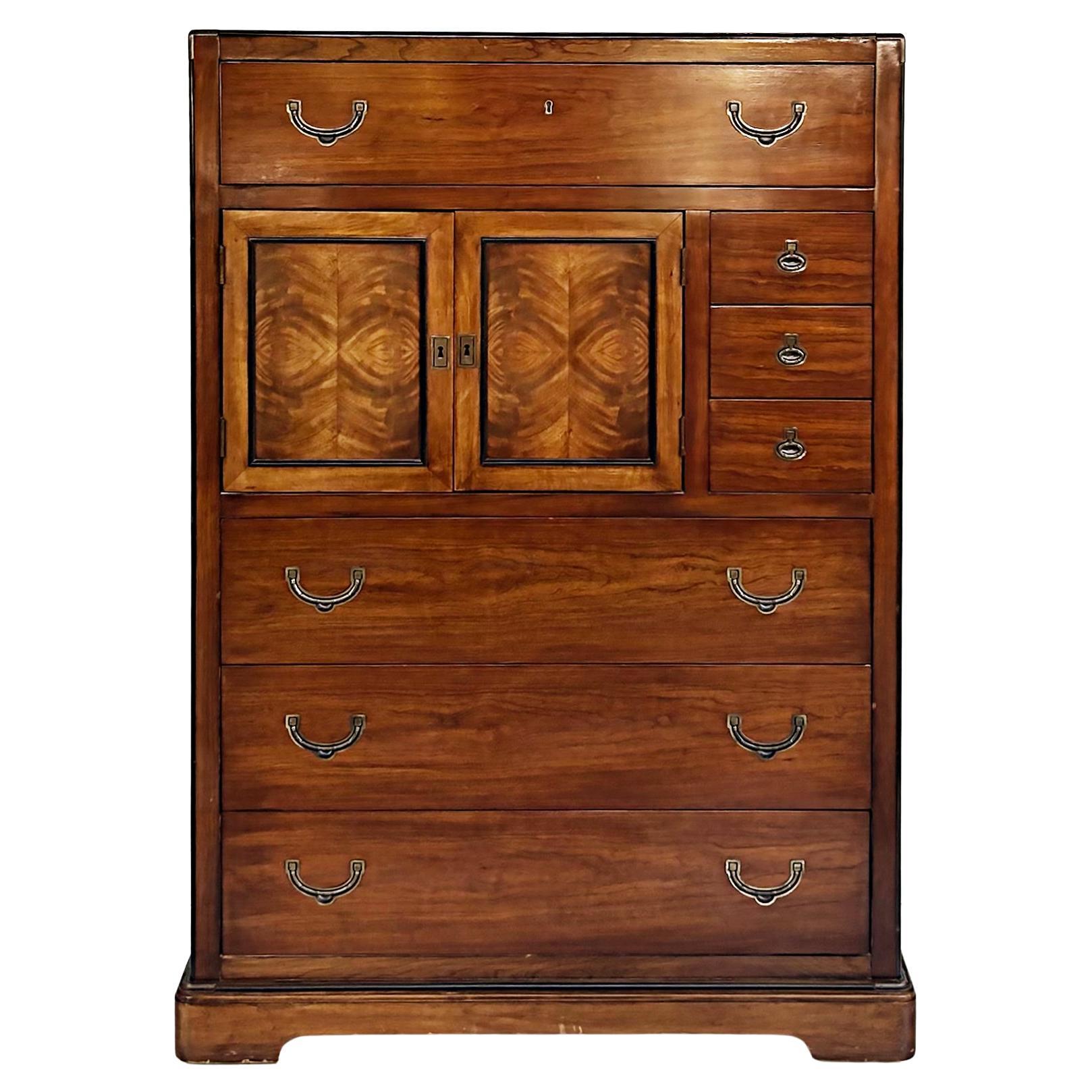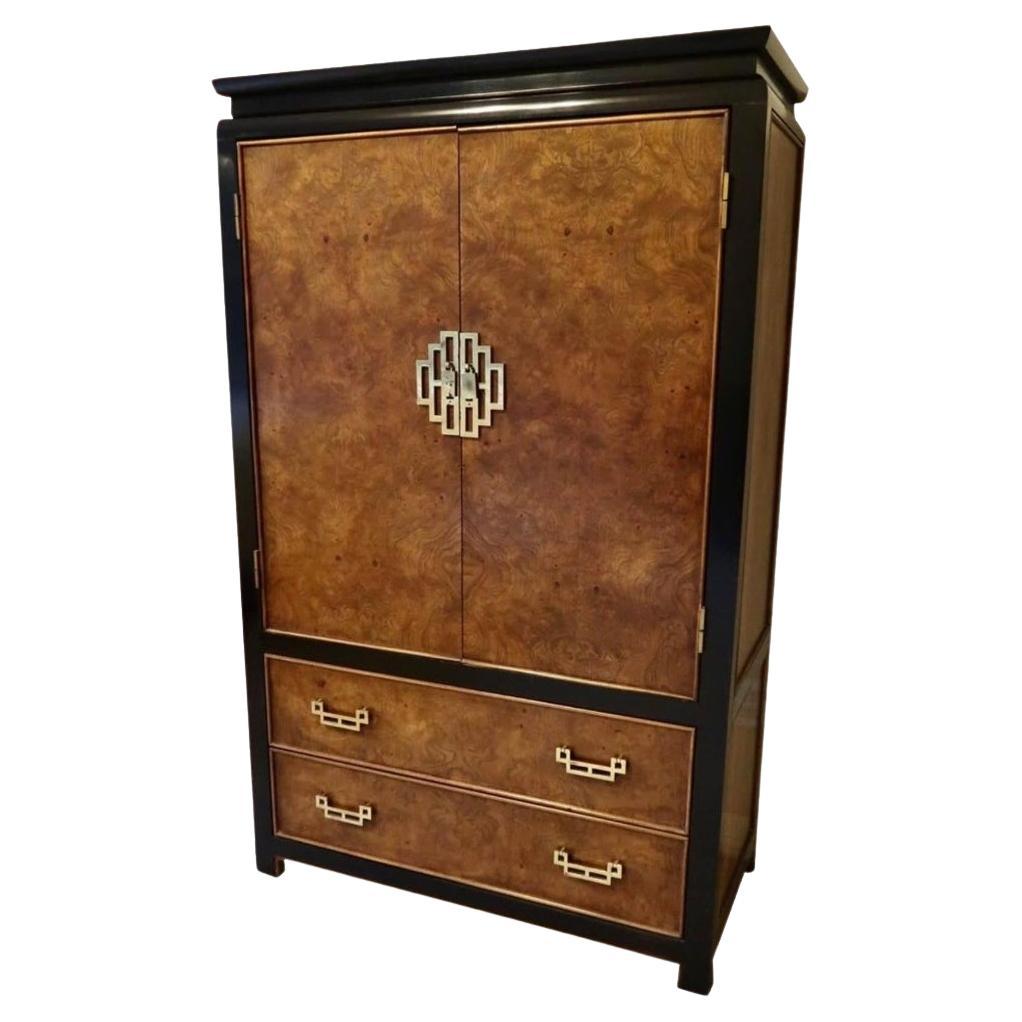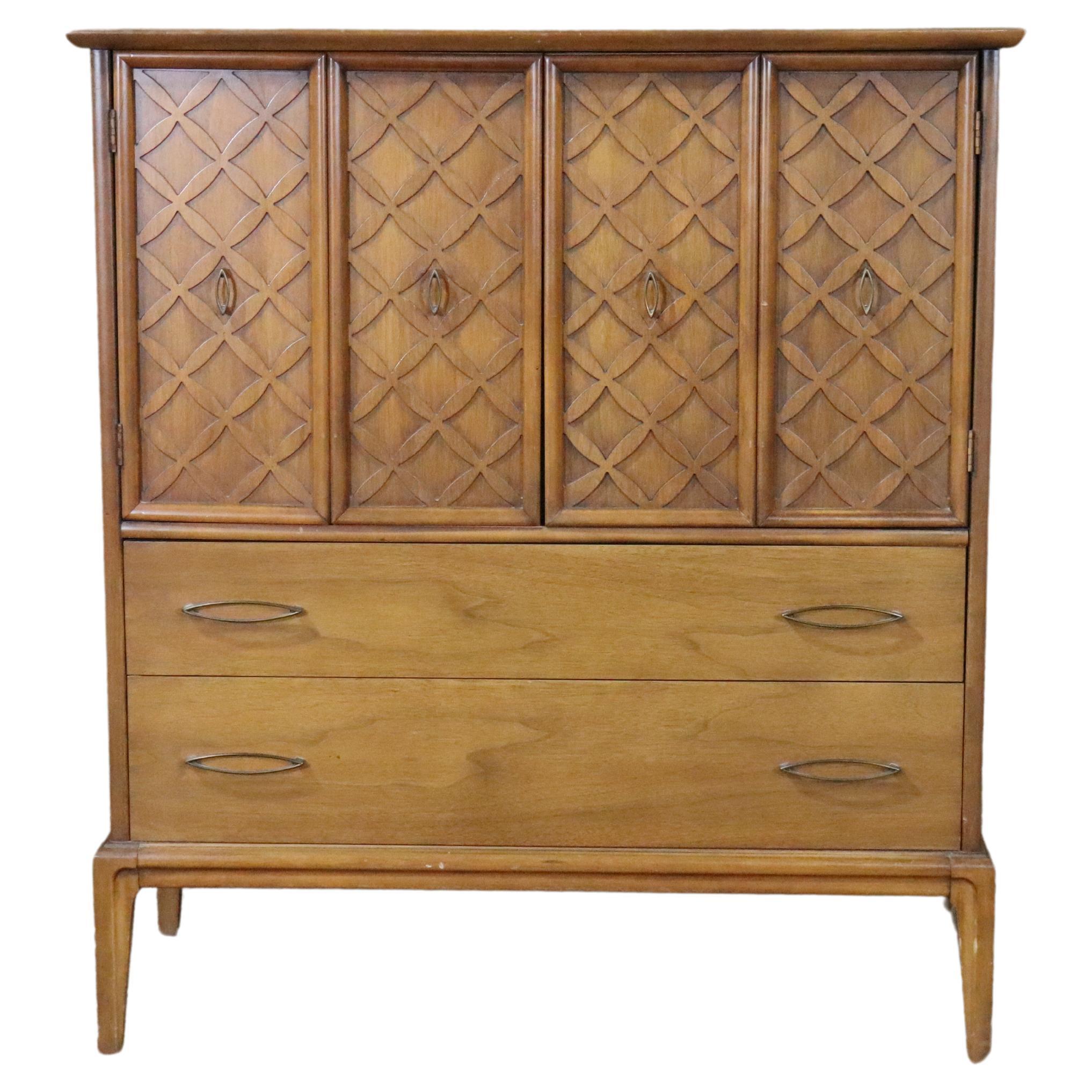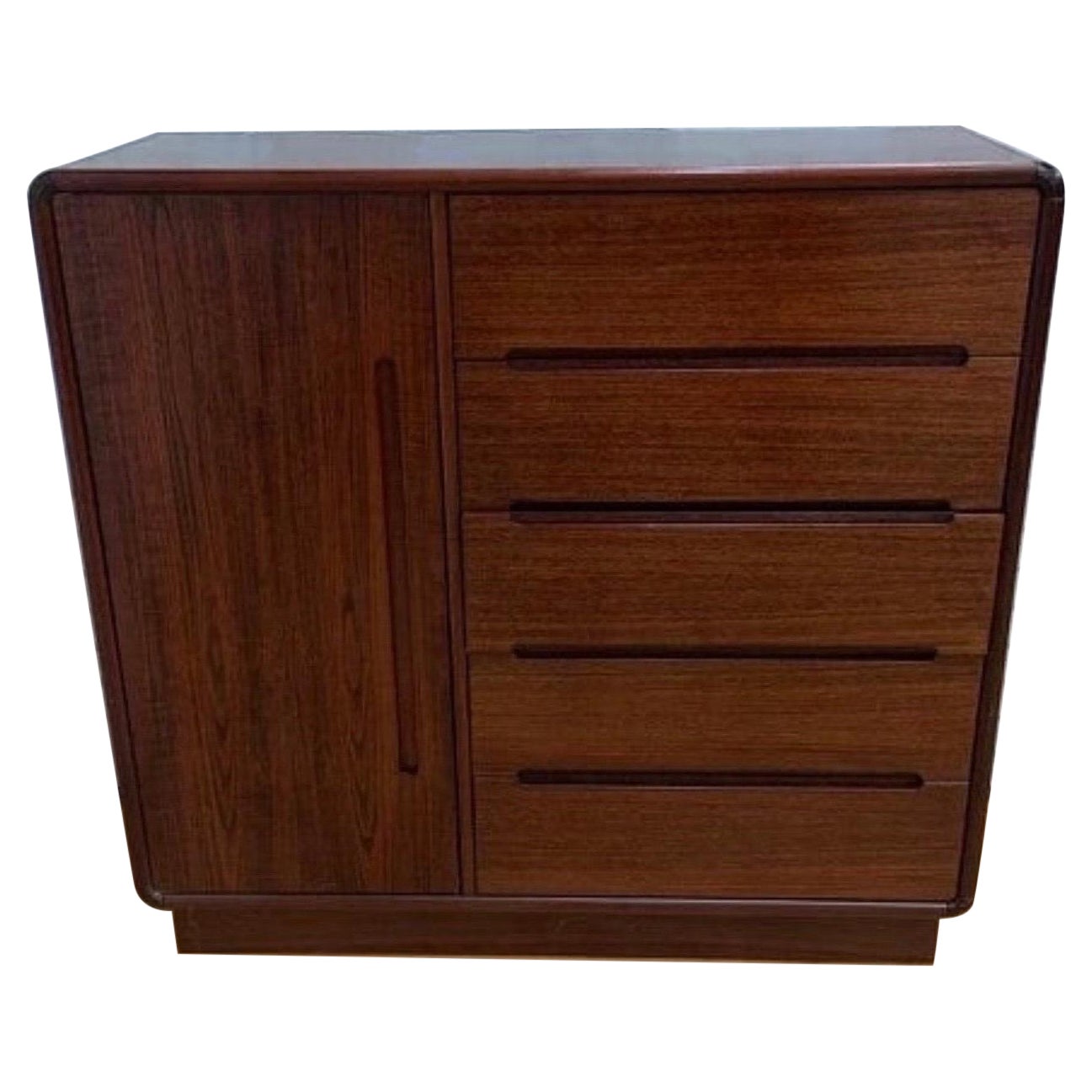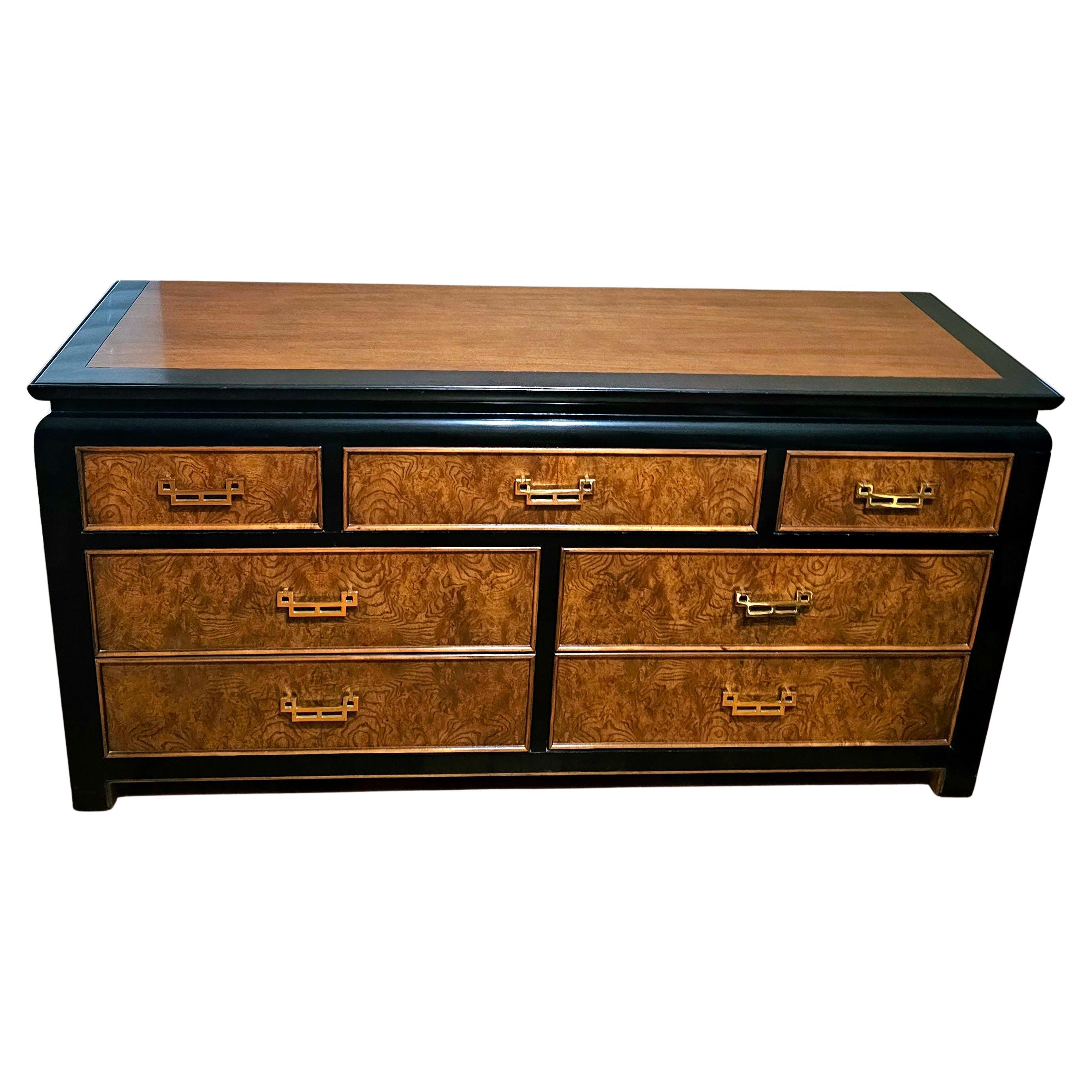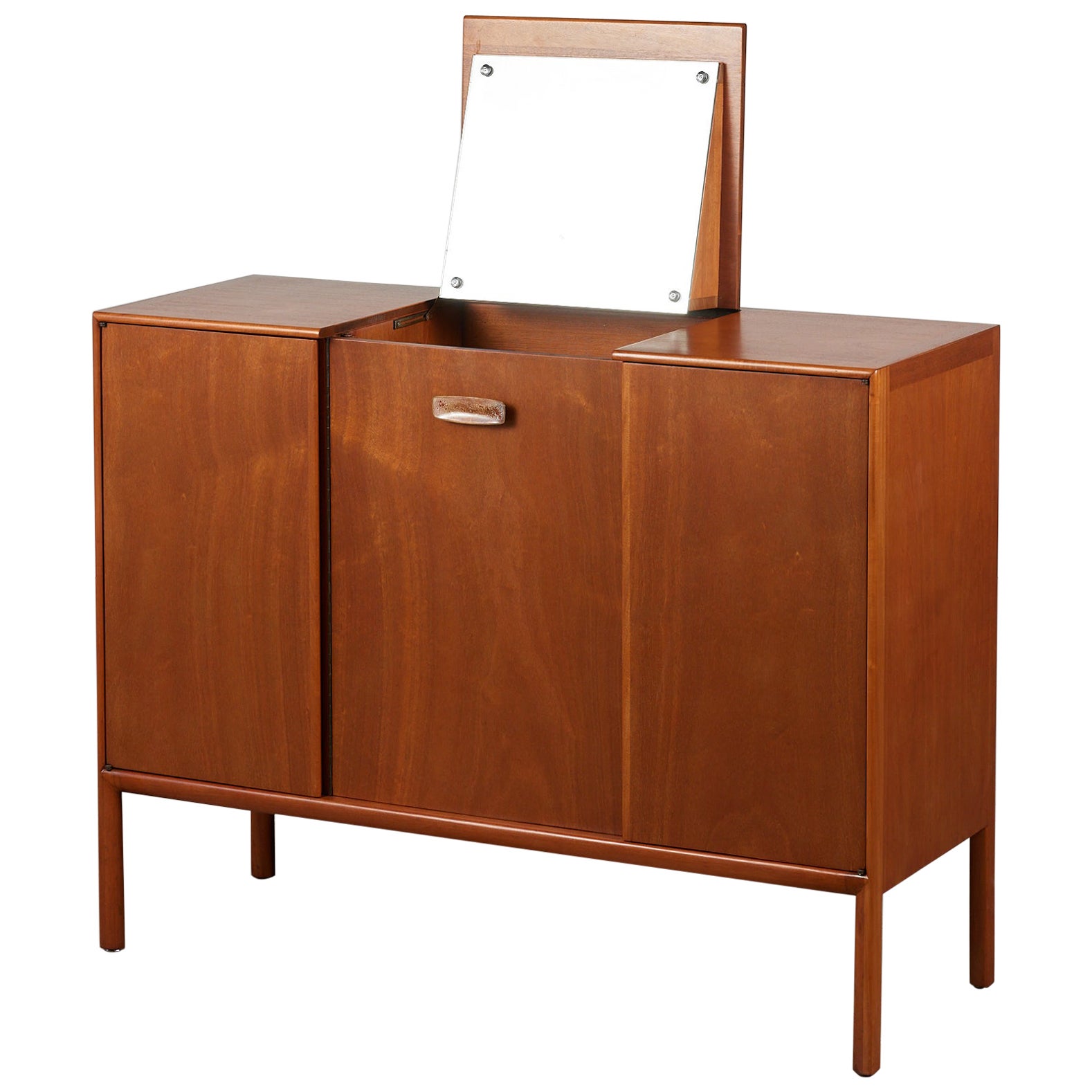Items Similar to Ray Sabota for Mt. Airy Gentleman's Cabinet w/ Vanity
Video Loading
Want more images or videos?
Request additional images or videos from the seller
1 of 21
Ray Sabota for Mt. Airy Gentleman's Cabinet w/ Vanity
About the Item
Ray Sabota For Mt. Airy Gentleman's Cabinet with vanity. Made of Mahogany wood and solid mahogany drawer fronts. Beautiful turquoise pull revels drawers. The dresser features three sleek door fronts which open to reveal interior storage. Center flip top drawer opens to reveal a mirror. Left door opens to four small drawers. Center and right doors open to three large drawers and one small drawer. This piece has been restored to a light mahogany exterior color and dark mahogany interior color, which gives it a beautiful two tone color.
Condition: Has been restored to excellent condition. Structurally sound. All drawers slide smoothly.
Dimensions: 52"L x 19"W x 40"H
- Creator:Raymond Sabota (Designer),National Mt. Airy (Manufacturer)
- Dimensions:Height: 40 in (101.6 cm)Width: 52 in (132.08 cm)Depth: 19 in (48.26 cm)
- Style:Mid-Century Modern (Of the Period)
- Materials and Techniques:
- Place of Origin:
- Period:
- Date of Manufacture:uknown
- Condition:Refinished. Condition: Has been restored to excellent condition. Structurally sound. All drawers slide smoothly.
- Seller Location:San Diego, CA
- Reference Number:1stDibs: LU6417236633002
About the Seller
5.0
Vetted Seller
These experienced sellers undergo a comprehensive evaluation by our team of in-house experts.
Established in 2020
1stDibs seller since 2022
44 sales on 1stDibs
Typical response time: 1 hour
- ShippingRetrieving quote...Ships From: San Diego, CA
- Return PolicyA return for this item may be initiated within 1 day of delivery.
More From This SellerView All
- Glenn of California Gentleman's Dresser by Richard ThompsonBy Glenn of California, Richard ThompsonLocated in San Diego, CAGlenn of California dresser or gentleman's chest designed by Richard Thompson. The case is made of walnut and has retractable inlaid rosewood pulls. The walnut is a golden warm color...Category
Mid-20th Century American Mid-Century Modern Dressers
MaterialsRosewood, Walnut
- George Nakashima "Origins' Walnut Dresser for WiddicombBy Widdicomb Furniture Co., George NakashimaLocated in San Diego, CAA very rare and exceptional mid-century Organic Modern monumental triple dresser. The Origins Group was created by George Nakashima, widely considered one of the world's greatest ...Category
Mid-20th Century American Mid-Century Modern Dressers
MaterialsBrass
- Stanley Young 6 Drawer Dresser for Glenn of CaliforniaBy Glenn of California, Stanley YoungLocated in San Diego, CAThis is a chance at a rare and high-quality dresser designed by Stanley Young for Glenn of California in the United States circa 1950’s. Like many of Young’s creations, this exceptio...Category
Vintage 1960s American Mid-Century Modern Dressers
MaterialsWalnut
- Arne Vodder "Triennale" Teak Dresser with Blue Bowtie Drawers for Sibast MøblerBy Arne VodderLocated in San Diego, CAAn iconic design by Arne Vodder 'Triennale' dresser was produced by Sibast Mobler, circa 1950. Constructed in teak, the long eight drawer dresser is a classic piece of danish modern ...Category
Mid-20th Century Swedish Scandinavian Modern Dressers
MaterialsTeak
- George Nelson Rosewood Thin Edge 4 drawer Dresser by Herman Miller #2By George NelsonLocated in San Diego, CAA rosewood thin edge chest designed by George Nelson for Herman Miller with exquisite rosewood grain and early original white porcelain handles. The George Nelson Rosewood Thin Edge 4-drawer Dresser, crafted by Herman Miller, epitomizes the timeless elegance and functional sophistication synonymous with mid-century modern design. This dresser stands as an iconic piece within the George Nelson collection, renowned for its clean lines, minimalist aesthetic, and impeccable craftsmanship. This particular example boasts exquisite rosewood grain and early original white porcelain handles. Constructed from rich rosewood veneer, the dresser boasts a warm, organic hue that exudes luxury and refinement. Its slender profile and thin edges create an illusion of lightness, enhancing the overall sense of modernity and grace. The 4 spacious drawers feature seamless integration of hardware, maintaining the dresser's sleek appearance while providing ample storage space for clothing, linens, or personal belongings. Each detail of the George Nelson Rosewood Thin Edge series reflects an unwavering commitment to both form and function. Its timeless design transcends trends, making it a versatile addition to any interior decor scheme, from minamalist to post-modern. Whether used in a bedroom, living area, or office space, this dresser elevates the ambiance with its understated elegance and unparalleled craftsmanship, showcasing the enduring legacy of George Nelson's visionary design ethos. About the Designer: Not everyone thinks of George Nelson when they think “Modernism”—but they should. Here’s why: Looking at the outset of George Nelson’s career, few would have guessed that his legacy would crown him as one of the most influential individuals in Modernism—story has it that the young Ivy Leaguer stumbled into the Yale School of Architecture seeking shelter from the rain, and only then did he consider studying design. His legacy, though, would be one that touched nearly every corner of American Modernism as we think of it today. As an architect, author, furniture designer, graphic designer, exhibition designer, teacher, amateur photographer, and general provocateur, George Nelson shaped the course of design in America for over four decades. After completing his two Bachelor’s degrees (one in architecture, the other in fine arts), Nelson went on to accept a traveling fellowship in Rome, which interfaced him with figures like Ludwig Mies Van Der Rohe, Walter Gropius, Le Corbusier, and Gio Ponti all of which he interviewed forPencil Point, bringing the European vanguard to the attention of the magazine’s American readership. At this point in his career, Nelson had devoted himself to writing, joining Architectural Forum as its first associate editor in 1935. For nearly a decade, Nelson’s post as an editor brought him face-to-face with many of the leaders of the Modernism movement in the U.S., and through these exchanges, his own stance in the design world began to solidify. For Nelson, the purpose of design was to improve the world in accordance with the laws of nature—and while he hadn’t yet done much designing himself, he was busy teasing out the theoretical details of architecture. In 1940, Nelson co-authored Tomorrow’s House with Henry Wright, and the book went on to be a great commercial success, introducing concepts like the “family room,” and more broadly assuming a solutions-based perspective for architectural design. It wasn’t long before the book earned him the favorable attention of D.J. Depree, the chairman of Herman Miller the American furniture manufacture. Despite Nelson’s inexperience in furniture design, Depree saw potential in the writer’s approach to the industry: solutions-oriented design with a practical lean. Nelson became the company’s Director of Design in 1947, under the condition that he be allowed to continue his work outside of the company. From 1947 to 1972, Nelson oversaw the design department at Herman Miller, bringing in the icons that would shape some of the most memorable pieces of mid-century design, from such people as Ray and Charles Eames and Harry Bertoia to Richard Schultz, Donald Knorr, and Isamu Noguchi. Beginning in the mid-1950s, Nelson’s own design firm began its work in earnest, producing furniture and pioneering a ubiquitous incorporation of design, bringing that same consideration for pragmatism and aesthetics to advertising and marketing materials, image management, and graphic programs. His own firm incorporated in 1955, tapping many of the same designers from the Herman Miller roster for collaborations under George Nelson Associates, Inc. It was during this period of Nelson’s life and career that many of his most iconic designs came onto the scene—many will be instantly familiar furniture silhouettes that perhaps you didn’t know sprung from George Nelson himself. Designing his first collection in 1945 and appointed design director in 1947, Nelson quickly expanded his purview and transformed the company. Confirming De Pree’s early assessment of Nelson as someone “thinking well ahead of the parade,” he redesigned everything from Herman Miller’s product line to its graphics and marketing and advertising materials. Over the course of his long association with Herman Miller, Nelson designed hundreds of pieces of furniture and recruited other designers, including Charles and Ray Eames, Alexander Girard, and Isamu Noguchi, now all widely acknowledged as some of the brightest talents of the time. Nelson developed his own designs—from furniture to architecture, and exhibitions to graphics—in his New York City studio, known variously over the years as George Nelson, George Nelson & Associates, and George Nelson and Company. The staff included significant designers in their own right such as Irving Harper, George Mulhauser, Ernest Farmer, Gordon Chadwick, George Tscherny...Category
Vintage 1950s American Mid-Century Modern Dressers
MaterialsAluminum
- Glenn of California Dresser by Richard ThompsonBy Glenn of California, Richard ThompsonLocated in San Diego, CAThis incredible 6 drawer dresser was designed by Richard Thompson for Glenn of California circa 1950s. It has a sleek walnut wood case with integrated legs and retractable inlaid ros...Category
Mid-20th Century American Mid-Century Modern Dressers
MaterialsRosewood, Walnut
You May Also Like
- Midcentury National Mt. Airy Campaign Tall Chest of Drawers, MahoganyBy National Mt. AiryLocated in Miami, FLMidcentury National Mt. Airy Campaign Tall Chest of Drawers, Mahogany Offered for sale is a large, monumental mid-century modern tall chest of drawers by National Mt. Airy Furnit...Category
Mid-20th Century American Mid-Century Modern Commodes and Chests of Drawers
MaterialsBrass
- 1970s Raymond Sabota Chin Hua Gentleman's DresserBy Raymond Sabota, Century FurnitureLocated in Waxahachie, TX1970s Burlwood and lacquer Classic chinoiserie Raymond K Sabota Chin Hua for Century Furniture Genuine Century two-tone chinoiserie armoire/ gentlemans dresser...Category
Vintage 1970s American Campaign Cabinets
MaterialsWood
- 1960s Gentleman's ChestLocated in Brooklyn, NYMid-century modern chest of drawers in walnut with brass cat eye handles and lattice front doors. Drawers plus storage space give you options for your bedroom. Please confirm locatio...Category
Mid-20th Century Mid-Century Modern Dressers
MaterialsWalnut
- Mid-Century Modern Danish Rosewood Gentleman's Cabinet/ArmoireLocated in Chicago, ILMid-Century Modern Danish Rosewood Gentleman's Cabinet/Armoire Gorgeous Mid-Century Modern Danish Rosewood Side By Side Dressing Cabinet/Armoire. This Chest is Beautifully Crafted...Category
Vintage 1960s Danish Mid-Century Modern Dressers
MaterialsRosewood
- 1986 Raymond K Sabota for Century Furniture Chin Hua Double DresserBy Raymond Sabota, Century FurnitureLocated in Waxahachie, TXRaymond K Sabota Chin Hua double dresser by Century Furniture. Classic two tone black lacquer and Burlwood with gorgeous Chin Hua brass hardware. On legs. 7 drawers. DOB April 1986 One owner Will come with copies of original 1986 Century Furniture catalog and receipts. Also have the queen bedroom...Category
Vintage 1980s American Chinoiserie Dressers
MaterialsBrass
- Mount Airy Furniture Vanity DresserBy Mount Airy Furniture CompanyLocated in Los Angeles, CAMahogany vanity by Mount Airy Furniture, circa 1960s, USA. The dresser features three sleek door fronts which open to reveal interior storage. The center door has a brass rectangular enameled door pull...Category
Vintage 1960s American Mid-Century Modern Wardrobes and Armoires
MaterialsBrass, Enamel
Recently Viewed
View AllMore Ways To Browse
Vanity Cases
Used Vanity Cabinets
Vintage Light Rays
Small Dark Wood Cabinet
Vintage Vanity Light
1960 Wood Small Cabinet
Used Vanity Dresser
Vintage Vanity Case
Dresser With Vanity
Gentlemans Cabinet
Vintage Vanity Cabinets
Large Vintage Drawer Pulls
Mid Century Modern Small Dresser
Midcentury Modern Small Dresser
Small Vanity Mid Century
Vintage Two Drawer Dresser
Vintage Vanity Storage
Small Walnut Dresser
